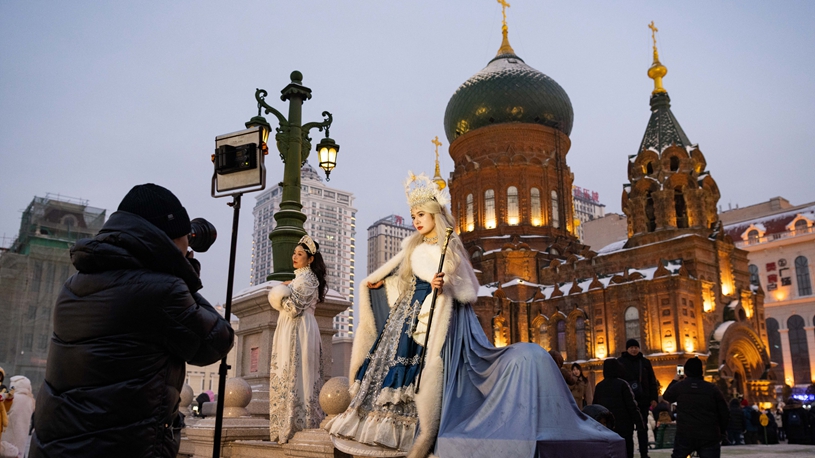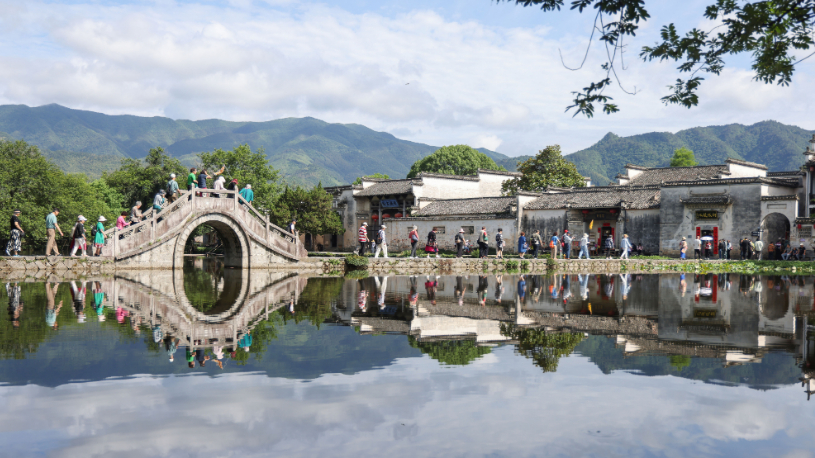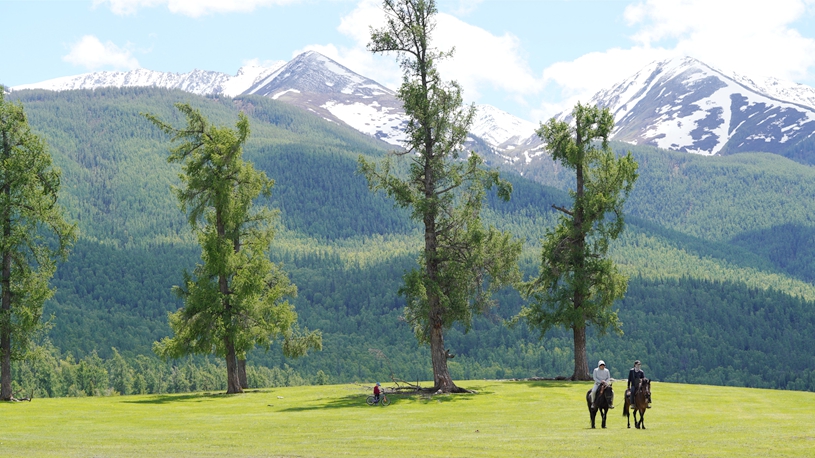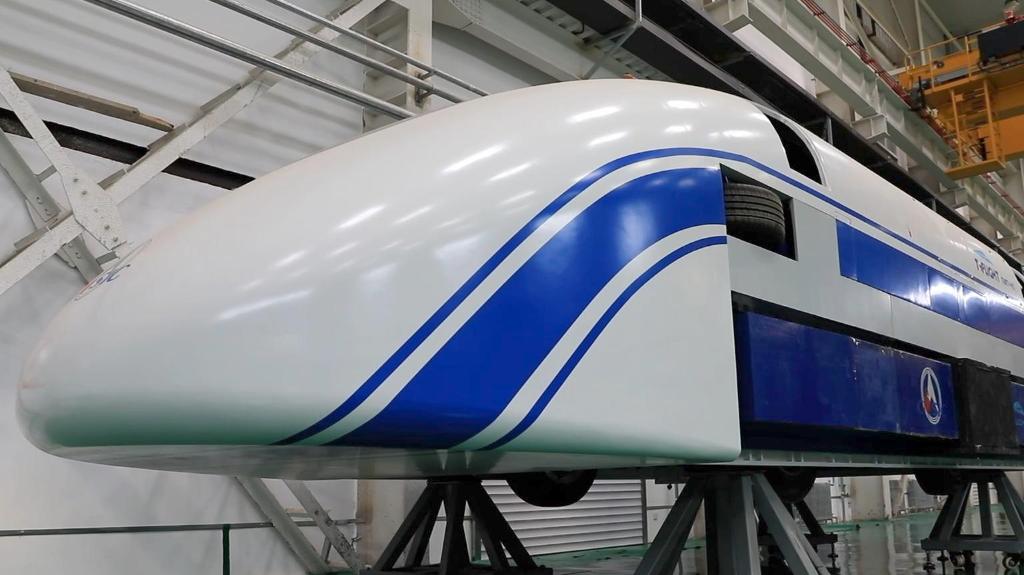*Harbin generously opened its arms to foreign cultures and innovatively integrated them. The vibrant tapestry of European traditions and Oriental culture is being well preserved, honored and celebrated today.
*Harbin, like many Chinese metropolises, has seen significant cultural development in recent years, which reflects the city's growth and increasing global outreach. Such development has further shaped the city's identity and enriched the lives of residents.
HARBIN, June 8 (Xinhua) -- While many Chinese cities are awash with tourists wearing traditional Chinese costumes posing for travel snapshots, visitors to Harbin in northeast China opt for Western-style aristocratic attire, fitting in well with the city's distinct Western heritage.
Also known as Ice City, the capital city of Heilongjiang Province is embracing its long-awaited summer after an extended period of cold days that could last until mid-April. Now Harbin's centerpiece tourist attraction Sophia Church, a centuries-old Byzantine-style building, provides an ideal setting for ladies wearing seemingly opulent attire for a marvel moment in their excursions.
"Harbin's buildings combine Chinese and Western elements. A photo-shoot here gets similar images like those taken abroad, so many people are coming for immersive experiences," said photographer Zheng Yi, who has recently opened up a photo shop in the downtown.
Iconic buildings such as Sophia Church stand as evidence of European migration, trade and culture that dated back to the late 19th and early 20th centuries after the construction of the Chinese Eastern Railway in 1898. Records show Harbin was once home to people from over 30 countries.
The city, with over 9 million residents, now boasts 16 different architectural styles -- Byzantine, neo-classical, art deco, baroque -- and its number of historical buildings accounts for over 1,000.
Yang Weidong, a researcher in city history, believes that the biggest difference between Harbin and other Chinese cities lies in its openness to foreign cultures.
Yang, who grew up in the city, is exhibiting over 500 artifacts dated from 1900 to 1940 at the Harbin Museum. The exhibits capture fading city memories through copies of building leases, film posters, an American raisin wrapper, and a 1931 newspaper ad declaring the opening of the "only modern hotel in town."
"Harbin generously opened its arms to foreign cultures and innovatively integrated them. The vibrant tapestry of European traditions and Oriental culture is being well preserved, honored and celebrated today. Such cultural identity has been part of the fabric of our daily lives," he said.
Harbin's historical buildings, a majority of which are found along the Central Avenue, are subject to a city-wide project that aims to create a digital database for the buildings.
As part of the project, QR codes will be generated for each building so that the public can have access to its history and recent developments. To date, data on more than 580 historical and cultural buildings have been collected, according to the city's natural resources and planning bureau.
The cultural fusion and diversity is also reflected in the city's culinary scene. A summer walk down the Central Avenue would not be complete without an ice cream, or gulping down a bottle of refreshing kvass, a traditional Eastern European bubbly beverage made from fermented bread.
"When I was a kid, a bottle of kvass and a piece of bread were probably the best meal," said Bian Jiang, now a marketing manager at Harbin Qiulin Beverage Technology Co., Ltd. The company's production techniques of kvass have been listed as intangible cultural heritage in Heilongjiang.
Bian said the kvass for Chinese buyers is probably milder than those made for Eastern European consumers. Banking on increased demand for health benefits in drinks, sales of the beverage increased in the past few years. In 2023, the company sold 53,000 tonnes of kvass and generated 300 million yuan (about 42.2 million U.S. dollars) in revenue.
"We are expanding our market outside Harbin and northeastern China to cities like Beijing and Shanghai to woo more young people," he said.
Harbin's dozens of private and public museums, galleries, and cultural institutions are also dedicated to preserving and promoting its heritage.
The Harbin Music Museum, home to over 1,500 western and Chinese musical instruments, testifies to decades of inter-cultural interactions. Museum curator Miao Di said the Harbin Symphony Orchestra, established in 1908, is considered the country's first orchestral music body.
"This reflects that the Chinese culture has a high level of inclusiveness and our culture has developed through blending with different cultures," Miao said.
Harbin, like many Chinese metropolises, has seen significant cultural development in recent years, which reflects the city's growth and increasing global outreach. Such development has further shaped the city's identity and enriched the lives of residents.
On the eve of China's Cultural and Natural Heritage Day, which falls on June 8 this year, young dancers from Harbin Ballet Troupe graced the auditorium of the Harbin Institute of Technology with renditions of Swan Lake, Le Corsaire and modern Chinese dance. The performance is part of the troupe's High Art into Schools project to showcase free high art into elementary, middle schools and higher institutions.
Tarasova Aleksandra, 29, a Russian student studying for a doctorate in architecture at the Harbin Institute of Technology, said that in Harbin, she feels at home especially with the familiar ballet, art, foods, architectures, and culture.
"When I finish my PhD, I plan to stay in China and work as an architecture teacher, or probably in an architecture company. By then, I would have been very familiar with the Chinese culture, too," she said.
(Video reporter: Wang He; Video editors: Zhang Nan, Hui Peipei, Wang Houyuan)■











